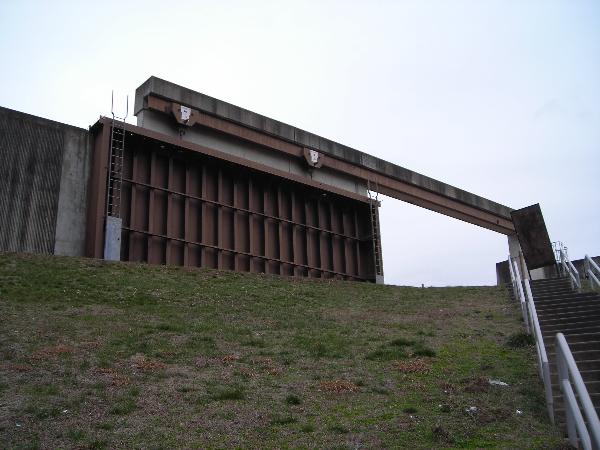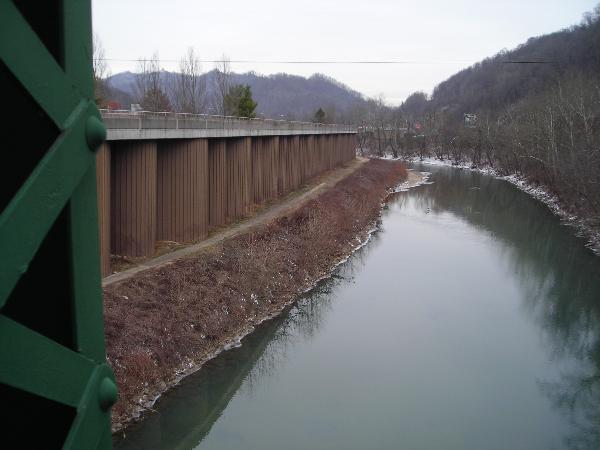Williamson, W. Va., located in a low-lying area bordering Kentucky, flooded 37 times in this century, which devastated the town, it's businesses and residents.
Williamson is now guarded by a $41 million floodwall built by the U.S. Army Corps of Engineers in 1991.
A flood wall (or floodwall) is a man-made primarily vertical barrier designed to temporarily contain the waters of a river or other waterway which may rise to unusual levels during seasonal or extreme weather events.
Flood walls are mainly used on locations where space is scarce, such as cities or where building levees or dikes would interfere with other interests, such as existing buildings, historical architecture or commercial exploitation of embankments.
The substantial costs of flood walls can be justified by the value of commercial property thus protected from damage caused by flooding.
A series of 41 circular sheet-pile cells and a length of conventional concrete wall form a U-shape around Williamson, beginning and ending at the mountains that rise up behind the town.

Design challenges included unstable riverbanks and intensive land use along the valley. The chosen solution will have a relatively long life and is easy to maintain.
Two pump stations move water to the Tug Fork River from Williamson's storm sewers and a creek that runs through the town.
A number of floodgates complete the barrier where roads and a railroad interrupt it.

The design of the cell wall was complicated by the soft in-situ clayey material, the unstable bank, and the cell’s unusual dual purpose as riverbank retaining wall during normal conditions and floodwall when the river rises.
Replacing the cohesive material with granular material, as is standard practice for this type of structure, would be expensive and cause temporary stability problems. The partial replacement of the cohesive material meant that engineers had to modify classic design methods that generally consider only granular cell fill.

The town, now protected from the ravages of flooding, bustles with activity. Businesses and residents alike benefit from the wall's protection from mother nature.
The greenspace created along the floodwall, provides a city park and biking and walking trails and other recreational opportunities.

In order to claim your find, please post a picture of yourself with your GPS in front of the floodwall at the Welcome to West Virgina sign.
In addition to your picture, please answer the following questions:
1) How long do you estimate the wall to be?
2) Estimate the height of the wall.
3) How many floodgates close to help protect the town?
4) Using your GPS or a compass, tell what direction the river flows past the town.
5) At the parking coords, tell how many forms of transportation are dipicted on the wall?
6) Finally, in your best estimate, provide the rate of flow of the Tug Fork River here?
Use the method outlined here: The formula for Feet per Minute is:
Distance (in feet) divided by time (in minutes) equal feet per minute or, D/T=fpm Calculator recommended!
Go to the first waypoint (N 37° 40.193 W 082° 16.599) and toss a stick or branch into the water and begin timing. (PLEASE don't throw trash into the river).
Go to the second waypoint approximately .24 miles away (N 37° 40.348 W 082° 16.758) and watch for your marker to come abreast of this location.
Note the total amount of time in minutes (to the nearest 1/2 minute) for it to float downstream even with you.
E-mail your answers to the profile above, do not disclose any information in your posts.